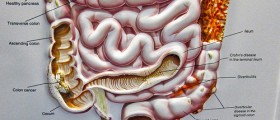
Introduction
Gastrointestinal tract spreads from the stomach and ends with the anus. Sometimes mouth and esophagus are also included in the term gastrointestinal tract. The bleeding can occur in each part of gastrointestinal tract.
All the bleeding is therefore classified as bleeding from the upper gastrointestinal tract and bleeding from lower gastrointestinal tract.
Bleeding from Upper Gastrointestinal Tract
Upper gastrointestinal tract consists of esophagus, stomach and the very beginning of small intestines called duodenum.
There is a variety of causes that can lead to upper gastrointestinal bleeding. Basically, the characteristic of this bleeding can reflect in vomiting of fresh or coagulated blood. Additionally, blood from these organs can mix with the stool giving it the dark brown or even black coloration.
The most common cause of upper gastrointestinal bleeding includes ulcers. Ulcers can be present in stomach and in duodenum. They rarely affect esophagus. Inflammation of stomach called gastritis is another cause of the bleeding. In patients suffering from liver cirrhosis the original place of bleeding may include esophageal varices. Malorry- Weiss tear affects mucous membrane of the esophagus.
Ingestion of certain caustic substances may lead to upper gastrointestinal bleeding.
And finally, malignant tumors of esophagus and stomach may be the cause of the bleeding.
Bleeding from Lower Gastrointestinal Tract
Lower gastrointestinal tract includes small intestines except for duodenum, large intestines and rectum. In case of this bleeding the blood can be either mixed with the stool giving it the dark brown or black coloration or it can be present on the surface of the stool.
Diverticulosis is only one cause of lower gastrointestinal bleeding. Diverticula are small pockets in the wall of the intestines and they are prone to inflammation and bleeding.
Angiodysplasia is after diverticulosis the most present cause of lower gastrointestinal bleeding. In this condition blood vessels are abnormal and can bleed easily. Angiodysplasia most commonly affects large intestines.
Polyps are benign tumors. If they are present in gastrointestinal tract they can be potentially malignant. Polyps can be one cause of the bleeding. The bleeding does not have to occur in all polyps. On the other hand, in case of malignant tumors of lower gastrointestinal tract the patient always loses blood and this eventually leads to anemia.
Certain inflammatory bowel diseases such as ulcerative colitis or Crohn's disease can be possible cause of bleeding. Even in some bacterial and parasitic diseases there can be blood in stool. Dysentery is only one example.
People who are suffering from hemorrhoids have to deal with occasional bleeding.
And finally, even the bleeding from anal fissures is classified as gastrointestinal bleeding.

















Your thoughts on this
Loading...